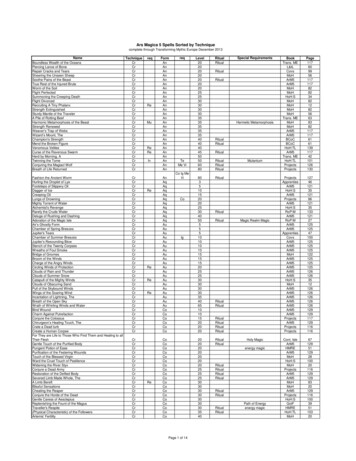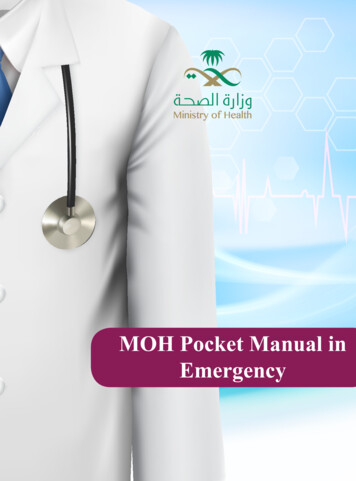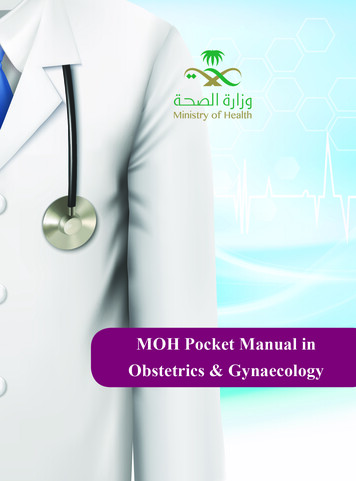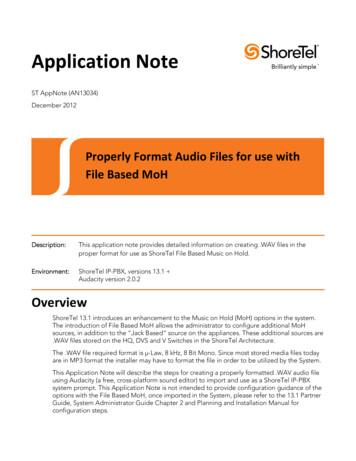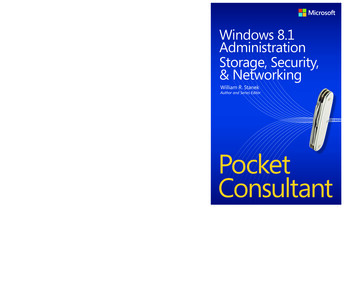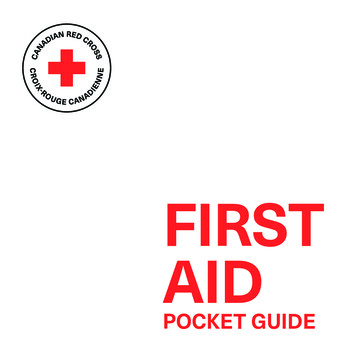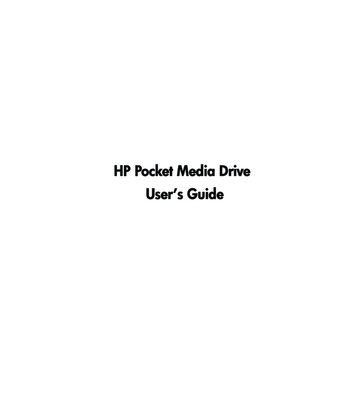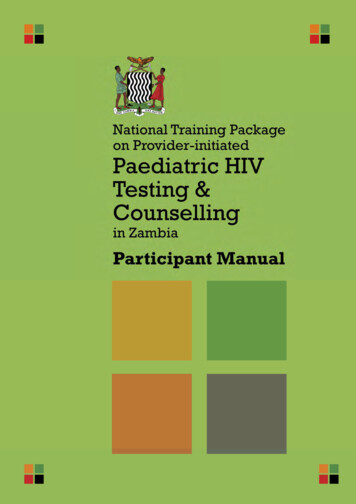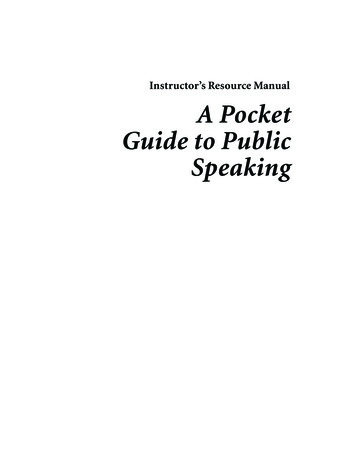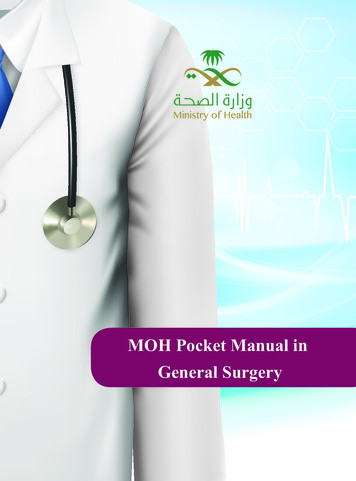
Transcription
MOH Pocket Manual inGeneral Surgery
MOH Pocket Manual in General SurgeryTable of ContentsChapter 1: Upper GIT5Perforated peptic ulcer6Gastric outlet obstruction10Upper GI bleeding14Chapter 2: Lower GIT17Bowel obstruction18Appendicitis23Anorectal diseaseAnal fissure28Fistual in ano31Hemorroid34Pilonidal sinus39Lower GI bleeding41Chapter 3: Hepatobiliary45Gallstones46Acute Chapter 4: Hernia61Chapter 5: Skin and soft tissue69Cellulitis and Erysipelas70Diabetic septic foot73Surgical site infection (SSI)76Chapter 6: Trauma81Table of Contents3
Chapter1UPPER GIT
MOH Pocket Manual in General SurgeryPerforated Peptic UlcerOverviewo Epidemiology The 15% death rate correlates with increased age, femalesex, and gastric perforations Severity of illness and occurrence of death are directlyrelated to the interval between perforation and surgicalclosureClinical Presentationo Symptoms Sudden, severe upper abdominal pain which typicallyoccurs several hours after the last meal There may be a history of previous dyspepsia, previousor current Treatment and Management for peptic ulceror ingestion of NSAID Rarely is heralded by nausea or vomiting Shoulder pain. Back pain is uncommono Signs The patient appears severely distressed, lying quietlywith the knees drawn up and breathing shallowly tominimize abdominal motion Fever and hypotension (late sign) The Epigastric tenderness may not be as marked asexpected because the board-like rigidity Tympanitic percussion over the liver and ileus6UPPER GIT
MOH Pocket Manual in General SurgeryDifferential Diagnosiso Hepatobiliary: hepatitis, cholecystitis, pancreatitis,cholangitiso Intestine: appendicitis, colitis, bowel perforation, ischemiao Extraabdominal: inferior myocardial infarction, basalpneumoniaWork Upo Laboratory CBC: leukocytosis Serum amylase mildly elevated ABG: metabolic acidosiso Imaging Erect chest x-ray: air under diaphragm in 85% CT scan abdomen with IV and PO contrast in doubtfulcasesTreatment and Management(See Flowchart 1)o Medical therapy (See Table 1) Non-operative management is appropriate only if thereis clear evidence that the leak has sealed (by contraststudy) in the absence of peritonitis IV antibiotic and proton pump inhibitorUPPER GIT7
MOH Pocket Manual in General Surgeryo Surgical therapy Laparotomy and omental patch for perforated duodenalulcer and prepyloric gastric ulcer Resection for gastric ulcer (most likely cancerous)Red Flago Acute onset or chronic symptomso Shock and peritonitiso Air under diaphragm but minimal symptoms and signs (sealedperforation)Reference1-Hassan Bukhari. Puzzles in General Surgery. 1st ed.Minneapolis: Tow Harbors Press 2013.8UPPER GIT
MOH Pocket Manual in General SurgeryUPPER GIT9
MOH Pocket Manual in General SurgeryGastric Outlet ObstructionOverviewo Epidemiology Occurs in 2% of patients with ulcer disease causingobstruction of pylorus or duodenum by scarring andinflammation Cancer must be ruled out because most patients who presentwith symptoms of gastric outlet obstruction will have apancreatic, gastric, or duodenal malignancyClinical Presentationo Symptoms Nausea, nonbilious vomiting contains undigested foodparticles, early satiety, bloating, anorexia, epigastric painand weight losso Signs Chronic dehydration and malnutrition Tympanitic mass (dilated stomach in the epigastric area and/or left upper quadrant Succussion splash in the epigastriumDifferential Diagnosiso Hepatobiliary: Pancreatitis, pancreatic cancero Stomach: volvulus, obstructed hiatus hernia, foreign body10UPPER GIT
MOH Pocket Manual in General SurgeryWork Upo Laboratory: CBC, electrolyte panel, Liver function testso Imaging Plain abdominal radiograph Contrast upper GI studies (Gastrografin or barium) CT scans with oral contrasto Upper endoscopy with biopsyTreatment and Management(See flowchart 2)o Medical therapy (See Table 1) Resuscitation and correction of electrolyte imbalance IV proton pump inhibitor NPO and NG tube H.pylori eradicationoSurgical therapy Antrectomy vs. vagotomy vs. dilatation / stentingRed Flagso Weight loss and anorexiao Unexplained anemiao Palpable massReferencesUPPER GIT11
MOH Pocket Manual in General Surgery1-Andres E Castellanos, MD; Chief Editor: John Geibel, MD, DSc, MA :Gastric Outlet Obstruction . eMedicine of Medscape2- Daniel T. Dempsey : Chapter 26. Stomach . Schwartz’s Principles ofSurgery, 9e , 20103-Gerard M. Doherty, MD, Lawrence W. Way, MD. CURRENT Work Upand Treatment and Management: Surgery, 13e , 20104-Maxine A. Papadakis, MD , Stephen J. McPhee, MD. Quick MedicalWork Up and Treatment and Management , 201312UPPER GIT
MOH Pocket Manual in General SurgeryFlowchart 2: Peptic Ulcer and Gastric Outlet ObstructionSuspecting peptic ulcerdisease based on historyand examinationInitial mamagementCBC, chemistry, coagulationliver function, amylaseErect chest x-rayNoRed Flag FeaturesEpigastric pain, severenanusea and non-bilious vomiting,weight loss, epigastricfullnessSimple,uncomplicatedpeptic ulcerProton pump inhibitorLifestyle modificationGastroenterology referralYesUrgent CTabdomen withPO IV contrastNoGastric outletobstructionYesRule out malignancySurgeryAnrectomy vs vagotomyDilatation/stenting isan optionH.pylori eradicationFailedResuscitationCorrection of electrolyteNPO, NGTProton pump inhibitor IVPantoprazoleEndoscopy to rule outmalignant causeH.pylori eradicationUPPER GIT13
MOH Pocket Manual in General SurgeryUpper GI BleedingOverviewo Definition: bleeding proximal to the ligament of Treitz, whichaccounts for 75% of GI bleedingo Etiology Above the GE junction: epistaxis, esophageal varices (10-30%),esophagitis, esophageal cancer, Mallory-Weiss tear (10%) Stomach: gastric ulcer (20%), gastritis (e.g. from alcohol orpost-surgery) (20%), gastric cancer Duodenum: ulcer in cap/bulb (25%), aortoenteric fistula postaortic graft Coagulopathy: drugs, renal disease, liver disease Vascular malformation: Dieulafoy’s lesion, AVMClinical Presentationo In order of decreasing severity of the bleed: hematocheziafollowed by hematemesis, coffee ground emesis, melena and thenoccult blood in stoolTreatment and Management(See flowchart 3)o Initial management (See Table 2) Resuscitation and monitoring (2 large bore IV lines, fluid,urinary catheter) Send blood for CBC, cross and type, coagulation profile,electrolytes, liver and kidney functions Keep NPO and insert NGT.14UPPER GIT
MOH Pocket Manual in General Surgery IV Proton pump inhibitors.§ It decreases risk of rebleeding if endoscopic predictors ofrebleeding are seen§ It is given to stabilize clot, not to accelerate ulcer healing§ If it is given before endoscopy, it decreases the need forendoscopic intervention In case of esophageal varices: IV octreotide (50 mcg loadingdose followed by constant infusion of 50 mcg/hr and IVantibiotic (ciprofloxacin) Consider IV erythromycin (or metoclopramide) toaccelerate gastric emptying prior to gastroscopy to improvevisualizationo Localization of the bleeder: esophagogastroduodenoscopy (EGD)o Definitive management EGD: establish bleeding site treat lesion Bleeding peptic ulcer: injection of epinephrine around bleedingpoint, thermal hemostasis (bipolar electrocoagulation or heaterprobe) and endoclips Variceal bleeding: banding or glue injection, the medicaltherapy / - TIPS.Reference1-Hassan Bukhari. Puzzles in General Surgery. 1st ed. Minneapolis: TowHarbors Press 2013.2- Jesse Klostranec, Toronto Notes 2012: Comprehensive MedicalReference, 28th edition. Toronto: Toronto notes 2012UPPER GIT15
MOH Pocket Manual in General SurgeryFlowchart 3: Upper GI BleedingSuspecting Upper GIbleeding based on historyand examinationInitial ManagementABC IV line resuscitationCBC, Chemistry, liver function, coagulationNGT for decompressionMedical TherapyProton pump inhibitor IVPantoprazole infusionSuspect esophageal varicesOctreotide IVAntibiotics: ciprofloxacinCause ofbleedingNoUpper yYesYesPeptic ulcerORDuodenotomy andsutureNoNoYesGastric / EsophagealvaricesRe-bleedingSengstaken tubePrepare for TIPSbanding/glueConservativetherapyHassan Bukhari. Puzzles in General Surgery. 1st ed. Minneapolis: Tow Harbors Press 201316UPPER GIT
Chapter2LOWER GIT
MOH Pocket Manual in General SurgeryBowel ObstructionOverviewo Definition: partial or complete blockage of the bowel resultingin failure of intestinal contents to pass through lumeno Pathogenesis Disruption of the normal flow of intestinal contents proximal dilation distal decompression May take 12-24 h to decompress, therefore passage of fecesand flatus may occur after the onset of obstruction Bowel ischemia may occur if blood supply is strangulated orbowel wall tension lesion leads to venous congestion Bowel wall edema and disruption of normal bowel absorptivefunction increased intraluminal fluid transudative fluidloss into peritoneal cavity, electrolyte disturbanceso Etiology Small bowel obstruction (SBO)§ Extramural: Adhesions (most common), hernia§ Intraluminal: Intussusception, gallstones ileus, bezoar.§ Intramural: Crohn’s disease, radiation stricture and tumors Large bowel obstruction (LBO)§ Intramural: Cancers (most common), diverticulitis, crohn’sstricture§ Extramural: Volvulus and adhesions Pseudo-obstruction (functional): paralytic ileus, electrolytedisturbance, drugs18LOWER GIT
MOH Pocket Manual in General SurgeryClinical Presentationo Must differentiate between obstruction and ileus, andcharacterize obstruction as acute vs. chronic, partial vs.complete (constipation vs. obstipation), small vs. large bowel,strangulating vs. non-strangulating, and with vs. withoutperforation / ischemia.o Nausea, vomiting, abdominal pain, abdominal Distention andconstipationo Complications (of total obstruction) Hypovolemia (due to third spacing) and bacterialtranslocation Strangulation (10% of bowel obstructions): a surgicalemergency§ Cramping pain turns to continuous ache, hematemesis andmelena (if infarction)§ Fever, tachycardia, peritoneal signs and early shock§ Leukocytosis and metabolic acidosis Perforation: secondary to ischemia and luminal distentionDifferential Diagnosiso Small bowel: mesenteric ischemia, bowel perforation, Crohn’sdiseaseo Large bowel: diverticulitis, colitis, appendicitiso Hepatobiliary: cholecystitis, pancreatitisLOWER GIT19
MOH Pocket Manual in General Surgeryo Peptic ulcer disease (perforation)o Aortic aneurysemWork Upo Laboratory May be normal early in disease course CBC: hematocrit (hemoconcentration) Electrolytes: to assess degree of dehydration Amylase elevated Metabolic alkalosis due to frequent emesis In case strangulation: leukocytosis with left shift, lacticacidosis and elevated LDH (late signs)o Radiological Upright CXR or left lateral decubitus (LLD) to rule out freeair, usually seen under the right hemidiaphragm Abdominal x-rays to determine SBO vs. LBO vs. ileus§ Erect (air fluid levels), Supine (dilated bowel).§ In case of ischemic bowel: look for free air, pneumatosis,thickened bowel wall, air in portal vein, dilated small and largebowels, thickened or hose-like haustra (normally thin finger-likeprojections) CT scan§ It provides information on level of obstruction, severity andcause§ Important to r/o closed loop obstruction, especially in the elderly20LOWER GIT
MOH Pocket Manual in General Surgery§ Upper GI series/small bowel series for SBO (if no causeapparent, i.e. no hernias, no previous surgeries) can be used MRI in pregnant patientsTreatment and Management(See flowchart 4)o Initial management (See Table 1) Resuscitation and electrolyte correction (with normal saline/Ringer’s first, then add potassium after fluid deficits arecorrected) NG tube to relieve vomiting, prevent aspiration anddecompress small bowel by prevention of further distentionwith swallowed air Foley catheter to monitor in/outs Antibiotic in case of strangulation or perforationo Definitive management Conservative therapy Especially if adhesions are the cause Indication for surgery: virgin abdomen, peritonitis,perforation and septic shockReference1-Hassan Bukhari. Puzzles in General Surgery. 1st ed. Minneapolis: TowHarbors Press 2013.2- Jesse Klostranec, Toronto Notes 2012: Comprehensive MedicalReference, 28th edition. Toronto: Toronto notes 2012LOWER GIT21
MOH Pocket Manual in General SurgeryFlowchart 4: Bowel ObstructionSuspecting bowelobstruction based on historyand examinationInitial managementCBC, chemistry, ABG, IV lineErect chest x-rayAbdominal x-ray (2 views)Nasogastric tubeFoley m metronidazolePip/Taz forsevere sepsisUrgent ORYesRedflag presentationVirgin abdomen, shock peritonitisNoLarge bowelobstructionon CTVolvulusSigmoidoscopyfailedlaparotomy andresection ostomyFluidadministrationConservative therapyClose monitoringObtain CTabdomenMalignantDivertingostomy vs.formalresection solysis /- resectionSmall bowelobstructionon CTHerniaGroin explorationViable bowelmesh repair.Dead bowelresect hemiorrhaphyHassan Bukhari. Puzzles in General Surgery. 1st ed. Minneapolis: Tow Harbors Press 2013.22LOWER GIT
MOH Pocket Manual in General SurgeryAcute AppendicitisOverviewo Pathophysiology Obstruction of appendiceal lumen from lymphoidhyperplasia in wall of appendix (children) or fecalith (adult)Clinical Presentationo Symptoms Vague, often colicky, periumbilical or epigastric pain thatshifts to right lower quadrant, with steady ache worsened bywalking or coughing In 95% of patients with acute appendicitis, anorexia isthe first symptom, followed by abdominal pain, which isfollowed in turn by vomiting Constipationo Signs Low-grade fever ( 37.8 C) in the absence of perforation Localized tenderness with guarding in the right lowerquadrant and rebound tenderness Psoas sign (pain on passive extension of the right hip) Obturator sign (pain with passive flexion and internalrotation of the right hip) Atypical presentations due to anatomic variations in theposition of the inflamed appendix§ Tenderness may be most marked in the flank§ Pain in the lower abdomen, often on the left; urge to urinate ordefecateLOWER GIT23
MOH Pocket Manual in General Surgery§ Abdominal tenderness absent, but tenderness on pelvic or rectalexaminationo Complications Perforation, appendicular abscess or phlegmon (mass) andpylephlebitis (suppurative thrombophlebitis of the portalvenous system)Differential Diagnosiso Mesenteric lymphadenitis, Gastroenteritis, Crohn’s diseaseo Renal: ureteric stoneo In female: ruptured ovarian cyst, ovarian torsion, ectopicpregnancyo Beware of “crossover” diseases like Sigmoid colon flopped into RLQ mimicking appendicitisWork Upo Laboratory CBC: Mild leukocytosis, (12,000 to 18,000 cells/mm3) Urinalysis can be useful to rule out UTI Pregnancy test if applicable24LOWER GIT
MOH Pocket Manual in General Surgeryo Imaging Ultrasound scan (pelvic) is indicated in young women ofchildbearing age if ovarian pathology is suspected CT scan is indicated: suspecting appendix mass or abscess,unclear Work Up and in elderly MRI in pregnant patiento Invasive Laparoscopy is a useful tool in case all above investigationsfailedo Elderly patients with appendicitis often pose a more difficultdiagnostic problem because of the atypical presentationTreatment and Management(See flowchart 5)o Preoperative antibiotics (See Table 1) All what is needed in case of appendicular mass phlegmon(followed by interval appendectomy) Antibiotic coverage is limited to 24 to 48 hours in cases ofnon-perforated appendicitis. and 7 to 10 days for perforatedappendixo Percutaneous drainage for appendicular abscesso Appendectomy open or laparoscopic.LOWER GIT25
MOH Pocket Manual in General SurgeryRed Flagso Females patient with missed menses or vaginal bleedo Elderly patient with atypical, recurrent symptoms and weightlosso Palpable mass on examinationReference1- Gerard M. Doherty, MD: Chapter 28. Appendix.Current Work up andTreatment: Surgery, 13e, 20102- Bernard M. Jaffe and David H. Berger : Chapter 30. The Appendix .Schwartz’s Principles of Surgery, 9e , 20103- Maxine A. Papadakis, MD , Stephen J. McPhee, MD : MENT , 20134- McLatchie, Greg; Borley, Neil; Chikwe, Joanna. Upper GastrointestinalSurgery . Oxford Handbook of Clinical Surgery, 3rd Edition , 20075-Hassan Bukhari. Puzzles in General Surgery. 1st ed. Minneapolis: TowHarbors Press 2013.26LOWER GIT
MOH Pocket Manual in General SurgeryFlowchart 5: Acute AppendicitisSuspecting appendicitisbased on historyand examinationInitial managementABC, IV lineCBC, ChemistryNoRed Flag PresentationFemale, elderly, atypical or recurrentsymptoms, long history, or/and palpablemass on examPreoperative antibioticsCefuroxim metronidazoleObtain consentBook for appendectomy(open vs. laparoscopy)Further work upB-hCG (married female)Urine analysisAbdominal ultrasoundCT abdomen (optional)OR findingPerforated appendixIntra-abdominal sepsis(IAS)NoContinuesameantibioticsfor 24hrsYes*Continueantibiotics for7-10 days formild IAS* Pip/taz inmodto severe IASYesPhlegmonor abscessNoManageaccording tothe resultof the abovementionedtestsYes* IV Cefuroximand metronidazole*Percutaneounsdrainage for abscess*Consider intervalappendectomyLOWER GIT27
MOH Pocket Manual in General SurgeryAnal FissureOverviewo Definition: is a tear in the anoderm distal to the dentate lineo Incidence: Most commonly occur in the posterior midline;10% occur anteriorlyo Etiology It is related to trauma from either the passage of hard stoolor prolonged diarrhea A lateral location of a chronic anal fissure suggests:Crohn’s disease, Syphilis, Tuberculosis, HIV/AIDS or analcarcinomaClinical Presentationo Symptoms Severe, tearing pain during defecation Sensation of intense and painful anal spasm lasting forseveral hours after a bowel movement Constipation and hematochezia (less common). Fissuresmay present as painless non-healing wounds that bleedintermittentlyo Signs Acute fissure is a superficial tear of the distal anoderm Chronic fissures: an ulcer with heaped-up edges. The whitefibers of the internal anal sphincter visible at the base of theulcer and associated external skin tag and/or a hypertrophiedanal papilla internally28LOWER GIT
MOH Pocket Manual in General SurgeryDifferential Diagnosiso Thrombosed hemorrhoido Perianal fistula or abscessWork Upo Work Up is confirmed by visual inspection of the anal vergewhile gently separating the buttockso Digital (by touching the anal sphincter, anal spasm will beappreciated) and anoscopic examinations may cause severepain and may not be possibleo Examination under anesthesia (EUA) if in doubt or there issuspicion of another cause for the perianal painTreatment and Management(See flowchart 6)o Medical therapy (See Table 4) Life-style modification, stool softener and sitz bath Local analgesia Local nitroglycerin or calcium channel blocker (nifedipine- less side effects).o Surgical therapy Partial Lateral internal sphincterotomy for refractory andchronic fissureLOWER GIT29
MOH Pocket Manual in General SurgeryRed Flagso New onset in an elderly patiento Unexplained anaemia, tenesmus or weight losso Family history of bowel cancer or inflammatory bowel diseaseo Associated anal mass or enlarged groin masso Positive faecal occult blood testReference1-Lisa Susan Poritz, MD; Chief Editor: John Geibel, MD, DSc. eMedicineof Medscape2-Kelli M. Bullard Dunn and David A. Rothenberger. Schwartz’sPrinciples of Surgery, 9e , 20103-Mark L. Welton, MD, Carlos E. Pineda, MD, George J. Chang,MD, Andrew A. Shelton, MD. CURRENT Work Up & Treatment andManagement: Surgery, 13e , 2010.4-Maxine A. Papadakis, MD , Stephen J. McPhee, MD. Quick MedicalWork Up & Treatment and Management , 20135-Hassan Bukhari. Puzzles in General Surgery. 1st ed. Minneapolis: TowHarbors Press 2013.30LOWER GIT
MOH Pocket Manual in General SurgeryFistula in AnoOverviewo Definition: an abnormal tract or cavity with an external openingin the perianal skin which is communicating with the rectum oranal canal by an identifiable internal opening.o Pathophysiology History of previous anorectal abscess, which was drainedspontaneously or surgicallyClinical Presentationo Symptoms: perianal discharge, pain, swelling and/or bleedingo Signs Perianal exam: an external opening that appears as anopen sinus or elevation of granulation tissue. Spontaneousdischarge of pus or blood via the external opening may beapparent or expressible on digital rectal examination. Digital rectal examination may reveal a fibrous tract or cordbeneath the skin. It also helps to delineate any further acuteinflammation that is not yet drained. Lateral or posteriorinduration suggests deep postanal or ischiorectal extension. The sphincter tone and voluntary squeeze pressures shouldbe assessed before any surgical therapy.LOWER GIT31
MOH Pocket Manual in General SurgeryClassificationo Four main types Intersphincteric: the track is in the intersphincteric plane.The external opening is usually in the perianal skin close tothe anal verge Transsphincteric: The fistula starts in the intersphinctericplane or in the deep postanal space. The track traversesthe external sphincter, with the external opening at theischioanal fossa. Horseshoe fistula is also in this category Suprasphincteric: The fistula starts in the intersphinctericplane in the midanal canal and then passes upward to a pointabove the puborectal muscle. The fistula passes laterallyover this muscle and downward between the puborectalmuscle and the levator ani into the ischioanal fossa Extrasphincteric: The fistula passes from the perineal skinthrough the ischioanal fossa and the levator ani and finallypenetrates the rectal wallDifferential Diagnosiso Perianal abscesso Hemorrhoid32LOWER GIT
MOH Pocket Manual in General SurgeryWork Upo History and Physical Examinatioo Anoscopy is usually required to identify the internal opening.o MRI and Fistulogram in complex or recurrent typeso Proctoscopy or flexible sigmoidoscopy is performed to ruleout other lesions and inflammatory bowel diseaseTreatment and Management(See flowchart 6)o Abscess: incision and drainage (See Table 3)o Simple, superficial: fistulotomyo Crohn’s disease, anterior fistula in female, complex or high:seton, referral to colorectal surgeon for other options.Red Flagso History of Crohn’s disease or HIVo Anterior location or multiple fistulaeo Complex, recurrent or high locationLOWER GIT33
MOH Pocket Manual in General SurgeryReferences1-Juan L Poggio, MD, MS, FACS, FASCRS; Chief Editor: John Geibel,MD, DSc, MA : Fistula-in-Ano . eMedicine of Medscape2-Kelli M. Bullard Dunn and David A. Rothenberger: Chapter 29. Colon,Rectum, and Anus . Schwartz’s Principles of Surgery, 9e , 20103-Mark L. Welton, MD, Carlos E. Pineda, MD, George J. Chang,MD, Andrew A. Shelton, MD. CURRENT Work Up & Treatmentand Management: Surgery, 13e , 20104-Hassan Bukhari. Puzzles in General Surgery. 1st ed. Minneapolis: TowHarbors Press 2013.HemorrhoidsOverviewo Definition: Hemorrhoids are cushions of submucosal tissuecontaining venules, arterioles and smooth-muscle fibers thatare located in the anal canalo Types External hemorrhoids are located distal to the dentate lineand are covered with anoderm Internal hemorrhoids are located proximal to the dentate lineand covered by insensate anorectal mucosa Combined internal and external hemorrhoids34LOWER GIT
MOH Pocket Manual in General SurgeryClinical Presentationo Symptoms Bright red bleeding per rectum and mucus discharge When very large, a sense of rectal fullness or discomfort Pain during bowel movements (when thrombosed) Anal Itching Thrombosed external hemorrhoid§ Acute severe perianal pain§ The pain usually peaks within 48–72 hours§ It is a purple-black, edematous, tense subcutaneous perianalmass that is quite tender.§ Ischemia and necrosis of the overlying skin, resulting in bleedingo Signs: purple-colored swelling protruding through anuso Complications Incarceration, thrombosis and necrosis Severe bleeding Painful lumps in the anal areaClassificationo Internal hemorrhoids are graded according to the extent ofprolapse First-degree: bulge into the anal canal and may prolapsebeyond the dentate line on straining Second-degree: prolapse through the anus but reducespontaneously Third-degree: prolapse through the anal canal and requireLOWER GIT35
MOH Pocket Manual in General Surgerymanual reduction Fourth-degree hemorrhoids: prolapse but cannot be reduce.Differential Diagnosiso Perianal hematomao Perianal abscesso Rectal prolapseo Anal papillaWork Upo Rectal Examination: visual and digitalo Anaoscopy, proctoscopyo Colonscopy: to rule out colonic pathology especially 40years.Treatment and Management(See flowchart 6)o1st to 3rd degree (See Table 4) Medical therapy: diet/lifestyle modification, flavonoid, sitzbath and stool softener Surgical therapy: banding or sclerotherapy andhemorrhoidectomy 4th degree: hemorrhoidectomy36LOWER GIT
MOH Pocket Manual in General Surgeryo Thrombosed exernal hemorrhoid Medical therapy and analgesia Incision and evacuation of clotRed Flagso Weight loss, change in stool size and bowel habito Abdominal pain, anorexia or unexplained anemiao Family History of bowel cancer or inflammatory boweldiseaseo Elderly, HIV patientsReferences1-Kelli M. Bullard Dunn and David A. Rothenberger: Chapter 29. Colon,Rectum, and Anus . Schwartz’s Principles of Surgery, 9e , 20102-Mark L. Welton, MD, Carlos E. Pineda, MD, George J. Chang,MD, Andrew A. Shelton, MD. CURRENT Work Up & Treatment andManagement: Surgery, 13e , 20103-Maxine A. Papadakis, MD , Stephen J. McPhee, MD. Quick MedicalWork Up & Treatment and Management , 20134-Hassan Bukhari. Puzzles in General Surgery. 1st ed. Minneapolis: TowHarbors Press 2013.LOWER GIT37
MOH Pocket Manual in General SurgeryFlowchart 6: Anorectal DiseasesSuspecting anorectaldisease based on historyand examinationAnoscopy(If not painful)Hemorrhoid1st, 2nd and3rd degreeMedical therapy*Diet/lifestylemodification*Flavonoid*Sitz bath*Stool softenerBanding andsclerotherapyFailedHemorrhoidectomy38LOWER GITFissure*Incision anddrainage*Cefruxime icNoRed flagpresentationCrohn’s, anteriortype in female,complex,highFistulotomyAcuteLateral referralMedical therapyStool softenerSitz bathLocal topicalnifedipine
MOH Pocket Manual in General SurgeryPilonidal DiseaseOverviewo Definition Acute/chronic recurring abscess or chronic draining sinusover the sacrococcygeal or perianal regiono Incidence: most commonly in people aged 15-30 yearso Etiology Unknown. It is speculated that the cleft creates a suction thatdraws hair into the midline pits when a patients sitsClinical Presentationo Symptoms A painful, fluctuant mass in the sacrococcygeal region withpurulent dischargeo Signs Abscess: red, warm, local tenderness and fluctuation with orwithout induration Sinus: Midline natal cleft pit sinus§ Chronic draining sinuses with multiple mature tracts with hairsprotruding from the pitlike openingsLOWER GIT39
MOH Pocket Manual in General SurgeryWork Upo It is a clinical Work Up best elicited by history and physicalexamination findingsTreatment and Managemento Abscess: incision and drainage with antibiotic therapyo Sinus: excision (without closure or with modified closure ofskin).References1-Kelli M. Bullard Dunn and David A. Rothenberger: Chapter 29. Colon,Rectum, and Anus . Schwartz’s Principles of Surgery, 9e , 20102-Maxine A. Papadakis, MD , Stephen J. McPhee, MD. Quick MedicalWork Up & Treatment and Management , 20133-Mark L. Welton, MD, Carlos E. Pineda, MD, George J. Chang,MD, Andrew A. Shelton, MD. CURRENT Work Up & Treatmentand Management: Surgery, 13e , 20104-Hassan Bukhari. Puzzles in General Surgery. 1st ed. Minneapolis: TowHarbors Press 2013.40LOWER GIT
MOH Pocket Manual in General SurgeryLower GI BleedingOverviewo Definition: bleeding distal to ligament of Treitzo Etiology Upper GI source Anorectal disease: fissure and hemorrhoid Diverticular disease Vascular: angiodysplasia Neoplasm: benign (polyp) or malignant Inflammation: ulcerative colitis, infectious, radiation,ischemicClinical Presentationo Hematochezia, anemia, occult blood in stool and rarely melenaTreatment and Management(See flowchart 7)o Initial management Resuscitation and monitoring (2 large bore IV line, fluid,urinary catheter) Send blood for CBC, cross and type, coagulation profile,electrolytes, liver and kidney functiono Localization Insert NGT to rule out upper GI source if suspected.LOWER GIT41
MOH Pocket Manual in General Surgery Proctoscopy Colonoscopy for mild to moderate bleed RBC scan for stable patient with massive bleeding Angiogram for unstable patient with massive bleedingo Definitive management Colonoscopy and angiogram Surgery rarely indicated if conservative treatment fails.Reference1-Hassan Bukhari. Puzzles in General Surgery. 1st ed. Minneapolis: TowHarbors Press 2013.2- Jesse Klostranec, Toronto Notes 2012: Comprehensive MedicalReference, 28th edition. Toronto: Toronto notes 201242LOWER GIT
MOH Pocket Manual in General SurgeryFlowchart 7: Lower GI BleedingSuspecting Lower GIbleeding based on historyand examinationInitial ManagementABC IV line resuscitationCBC, Chemistry, liver funtion, coagulationNGT for rule out upper GI sourceAnoscopy to rule out anorectal sourceMinimal tomoderatebleedingNoRed flag presentationMassive bleedingYesColonoscopyStableNoAngiogramYesRBC ScanFailedEnteroscopyfailedsurgeryLOWER GIT43
Chapter3HEPATOBILIARY
MOH Pocket Manual in General SurgeryGall StonesOverviewo Risk Factors
MOH Pocket Manual in General Surgery UPPER GIT 1-Andres E Castellanos, MD; Chief Editor: John Geibel, MD, DSc, MA : Gastric Outlet Obstruction . eMedicine of Medscape 2- Daniel T. Dempsey : Chapter 26. Stomach . Schwartz s Principles of Surgery, 9e , 2010 3-Ge
